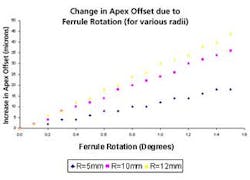Proper APC connectorization improves OSP performance
In today's fiber-to-the-premises network, consistent outside plant performance at specification levels dictated by passive optical network architecture requires careful control of the endface geometry parameters on angle polished connectors (APCs). In particular, apex offset is extremely critical in ensuring that glass-to-glass contact is maintained. APCs, designed and manufactured without anti-rotational features, may provide inconsistent interfaces through normal field use. These changing interfaces can create air gaps between the mated pair fiber cores, resulting in degraded or interrupted service.
A small ferrule rotation can change the apex offset of an APC by an unacceptable amount (Figure 1). Any APC or stick-and-click (SC) connector must be designed to minimize this rotation when the connector is in service.
Why does apex offset matter?
Apex offset is the distance between the center of the optical fiber and the apex of the polished ferrule endface radius (i.e., the high point of the ferrule) when the ferrule is viewed at 8°. If the distance between the apex and the fiber center is large, physical contact may be lost. The air gap created by the large apex offset will increase insertion loss and reflectance. Therefore, it's critical to keep apex offsets as low as possible.
Several industry standards are published that address APC endface geometry. The purpose of these specifications is to guarantee that rotation around the ferrule axis, which can change the apex offset (Figure 1), will not occur. The most common standard is IEC-60874-14-10. This standard defines apex offset of less than 50 microns in APCs. The other standard specifying APC endface is Telcordia GR-326, Issue 3. This standard references the IEC document and also specs a 50-micron maximum apex offset. A 50-micron apex offset, when combined with the radius and undercut requirements of these standards, will ensure that physical contact is made in extreme environmental conditions.
Ferrule rotation and apex offset
The apex offset that results from ferrule rotation is due to the fact that the endface is at an 8° angle. Physical contact results when the 8° planes of two mated connectors are parallel to each other. If one rotates about the ferrule axis, the planes are no longer parallel, which results in movement of the apex, increasing apex offset.
Figure 2 shows theoretical increase in apex offset for a variety of rotations and endface radii. A rotation as small as 1° can increase the apex offset by as much as 30 microns. This is more than 60% of the specification.
All APC/SC connectors are designed such that the ferrule can float within the connector housing. This float is needed because the ferrule is spring-loaded towards the front of the connector to ensure proper mating. However, this float allows the ferrule to rotate with respect to the connector key. A small rotation of the ferrule within the connector housing can increase the apex offset to a point where physical contact cannot be guaranteed. Loss of physical contact will increase insertion loss by at least 0.32 dB.
The issues of apex offset and ferrule rotation in APCs manifests when the connector is in service. The 8° angle is generally applied at the proper orientation when the APC is polished. Measured apex offsets are generally within specification because the ferrule hasn't had a chance to rotate within the connector body. However, the ferrule may rotate in the field during standard use. For example, when the connector is cleaned, a force could be applied that rotates the ferrule. In addition, multiple matings can cause the ferrule to rotate within the connector. Both will lead to increased apex offsets that could cause a loss of physical contact in APC/SC connectors.
It's important that APC/SC connector ferrules are forced back to their original position after they are rotated. This puts the ferrules in the position they were polished in, which guarantees good apex offsets.
In short, it's important that APCs maintain in-spec apex offset with regards to curvature radius and fiber height to help minimize the loss of physical contact. Any loss of physical contact will cause insertion return loss measurements to worsen. One way to guarantee physical contact is to use APCs whose ferrules won't permanently rotate within the connector housing. If the ferrule position permanently changes when it rotates, the observed apex offset could increase to a point where physical contact cannot be guaranteed.
Tom Kampf is director of Fiber Infrastructure at ADC (Minneapolis, MN).


